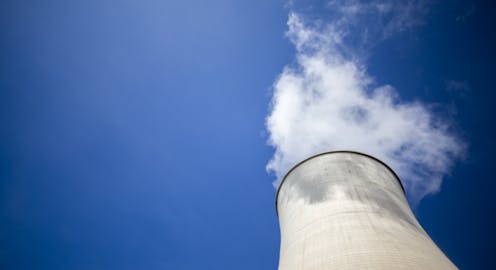What is amortisation, and what does it have to do with Peter Dutton’s nuclear proposal?
- Written by Jessica Yi, Course coordinator, University of South Australia

This article is part of The Conversation’s “Business Basics” series where we ask experts to discuss key concepts in business, economics and finance.
Nuclear power is expensive, but it remains a cornerstone of the Coalition’s plan to get Australia to net-zero emissions.
The federal opposition is yet to release its own costings for the proposal.
Nonetheless, federal Opposition Leader Peter Dutton caused something of a stir when in a recent speech, he said the costs of Australia’s nuclear plants could be “amortised” over their 80-year lifespan.
If hearing a word like “amortised” immediately makes your eyes glaze over, you’re probably not alone.
To make things even more confusing, Dutton may have confused the term with the closely related concept of “depreciation”. We’ll discuss why later.
But amortisation and depreciation are both important concepts in any corporate decision making.
So what exactly was the opposition leader talking about here, and what does it mean to write off the cost of an asset over time?
What is amortisation?
Amortisation has a wide range of applications across finance, including credit, loans and investment planning.
Here, though, we’ll focus on what amortisation means in the accounting context.
You might notice amortisation looks a bit like the more familiar term “mortgage”. This is because both are derived from the same root in Latin.
Amortise comes from “ad” – Latin for “to” – and “mortus” – which means “dead”.
Obviously, we usually don’t mean dead in a literal sense – rather, the more abstract process of bringing something to an end.
Spreading costs over time
In corporate accounting, amortisation is a technique used to gradually write down the cost or value of an intangible asset over its expected period of use.
It helps to think of intangible assets as things that don’t have a “grabbable” physical presence. Companies can operate using all kinds of intangible assets, such as copyrights, trademarks and patents.
In contrast, tangible assets are physical things like land, machinery, buildings and vehicles.
Companies can purchase intangible assets, but they can also generate them internally.
Finite or infinite
Intangible assets can also have a “finite” or “infinite” useful life. If deemed infinitely useful, an asset does not need to be amortised.
If only finitely useful, however, its economic benefit to a company will be systematically reduced over the span of its useful life.
To account for this, we list some of its consumption as an expense on the company’s balance sheet each year. This process helps spread the cost of an asset evenly over its life.
It’s important to note that amortisation is a “non-cash” expense. It appears on a company’s balance sheet as an expense and can lower profit, but it doesn’t affect a company’s cash flows.
How is it calculated?
There are a few different ways to calculate how costs should be spread over an asset’s useful life. For amortisation, one of the most common is the straight-line method.
Using the straight-line method, amortisation can be calculated by dividing an asset’s “depreciable amount” by its useful life.
The depreciable amount is the cost or value of an asset minus its “residual value” – what it is worth at the end of its useful life.
The residual value of an intangible asset will usually be zero, unless a third party has committed to purchase it at the end of its life, or its value can be determined on some active market.
What’s depreciation then?
You might be more familiar with the related term “depreciation”. Both accounting concepts refer to spreading the costs of long-life assets over their finite useful life.
The main difference is that amortisation is used to expense intangible assets while depreciation expenses tangible assets – physical things such as buildings, machinery and plant.
This leads to another key difference. Often, it is much easier to estimate the residual value of a tangible asset at the end of its useful life, because it or its component parts can be more easily sold.
Wait, how are nuclear reactors ‘intangible’?
Reading this, you may have spotted something. As explained above, the main difference between the “amortisation” and the “depreciation” is the type of depreciable assets.
If we go back to how Dutton used the concept of amortisation in his speech, we can reasonably conclude the term depreciation would have been more technically correct.
He was speaking specifically about the useful life of nuclear plants, which clearly have tangible, physical forms.
You could argue he was referring to one of amortisation’s other meanings: the amortisation of a loan or other liability in finance. Amortisation in this sense refers to spreading out loan payments over time.
This is unlikely, however, given he was specifically speaking about the useful life of the nuclear plants and the cost of depreciable assets.
Careful with your calculations
It should be noted that just because an asset has a long useful life, that doesn’t mean its amortisation or depreciation costs will be small.
Let’s look at some of the examples employed by Dutton: nuclear plants, touted to have 80 years of useful life, and renewables, such as wind turbines with 20 to 30 years.
It might be tempting to assume nuclear plants would have a lower depreciation expense, with a significantly longer useful life, but that risks ignoring their enormous initial upfront costs and continuous restructure costs that need to be capitalised.
If the initial and capitalised cost or value of nuclear plants are significantly greater than those of renewables, the annual depreciation expense of nuclear plants could end up being significantly greater.
It all depends on what goes into the equation. Depreciating costs can’t give us anything for free.
Authors: Jessica Yi, Course coordinator, University of South Australia





